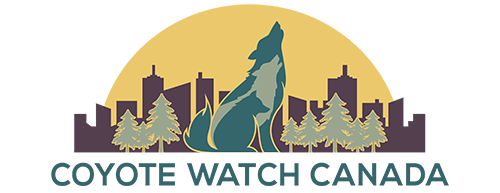The Beauty of Coyote Communication by Rick Lamplugh
Recently Mary and I had the good fortune to watch a family of Yellowstone coyotes as they shared a meal. We stumbled upon them while hiking in snow along the Gardner River. Surprised, we stopped in our tracks and hid behind a Juniper tree on a hill. The coyotes were about 150 yards away, downwind, and on the other side of the river. We made sure that our presence did not change their behavior, though they probably caught our scent and knew we were present.
After a few moments, Mary and I had calmed down enough to realize that this interaction would be great to video now and study later. Mary filmed this minute-and-a-half segment and a lot more. After about 45 minutes, the coyotes—having eaten their fill—retreated to the sage to rest and digest. Ravens and magpies moved in. We snuck back the way we had come and rushed home to download footage.
I immediately sent a copy of this video to our friend, Lesley Sampson, the executive director of Coyote Watch Canada, a national advocacy organization. (I am on their advisory board.) Lesley wrote her Honors thesis on canid behavior and devised a coding system for field observation, recording and analyzing coyote behavior that represents pack dynamics and identifies alpha, beta and omega members.
The following morning, we spent an hour on the phone to Lesley in Ontario. We went through the video again and again, pausing at specific time points to study, analyze, and remark on the incredible range of subtle behaviors and non-verbal communication.
Lesley said that the coyote entering the film in the beginning with its ears flat and to the side is one of the alphas of this pack. The alpha proceeds to use what we call the “alligator move” (mouth open, guard hairs up, back arched, tail tucked, legs stiff) to give three other pack members (likely the alpha’s offspring) a clear message: “It’s my turn to eat.” The message is received with no harm done to any family member. Lesley said this was a great example of how coyotes understand and live by pack rules.
While the alpha eats, three of the other pack members—likely sibling pups—interact, practicing levels of dominance. The fourth coyote on the bank, may not be related or may be from a different litter, Lesley said as she watched its standoffish behavior.
We could have gone on longer watching this family interact; Lesley’s enthusiasm was contagious and her knowledge compelling.
I hope you enjoy the beautiful way coyotes communicate, and, as always, I’d love to read your comments.
Rick Lamplugh is a coyote and wolf advocate and author of the bestselling In the Temple of Wolves: A Winter’s Immersion in Wild Yellowstone.
Available as eBook or paperback at http://amzn.to/Jpea9Q
Or as a signed copy from the author at http://bit.ly/1gYghB4

